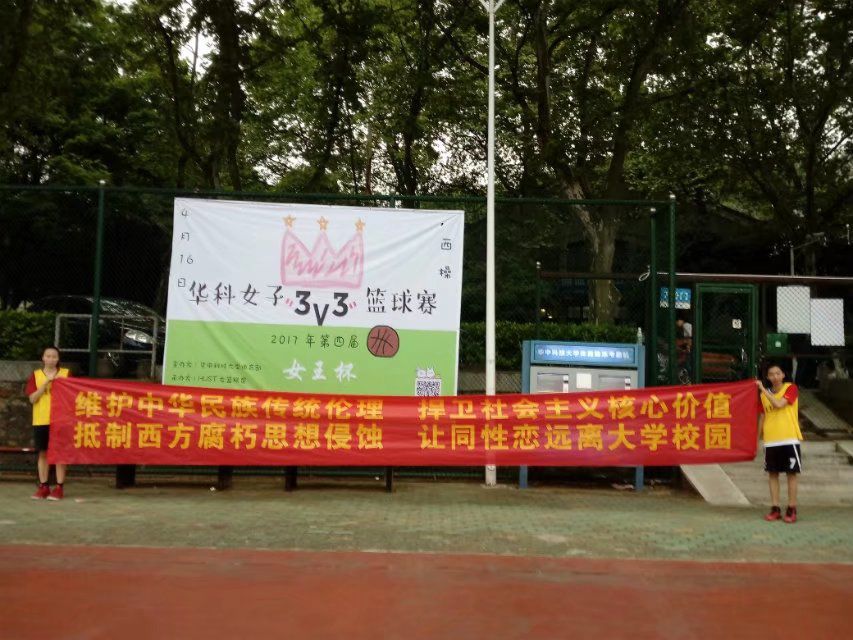Schooled on singular "they"
[This is a guest post by Bean]
My eight-year-old daughter in conversation with me last night:
Scene: I am giving her a sock, which she had brought home, only to find she already had both of her socks. So it logically must belong to some other girl (it's obviously a girl's sock).
Me: So, bring this lost sock back to school, and put it in the lost and found. Do you remember who was wearing it? Well, anyway if the other girl is looking for it she can find it. I'm assuming it was a girl so I'm going with "she".
Daughter [scornfully]: You mean "they".
Read the rest of this entry »
The language of homophobia on a Chinese campus
Banner displayed on the main campus of Huazhong University of Science and Technology in Wuhan, capital of Hubei Province, by members of the women’s basketball team:
Read the rest of this entry »
Electric sheep
A couple of recent LLOG posts ("What a tangled web they weave", "A long short-term memory of Gertrude Stein") have illustrated the strange and amusing results that Google's current machine translation system can produce when fed variable numbers of repetitions of meaningless letter sequences in non-Latin orthographic systems. [Update: And see posts in the elephant semifics category for many other examples.] Geoff Pullum has urged me to explain how and why this sort of thing happens:
I think Language Log readers deserve a more careful account, preferably from your pen, of how this sort of craziness can arise from deep neural-net machine translation systems. […]
Ordinary people imagine (wrongly) that Google Translate is approximating the process we call translation. They think that the errors it makes are comparable to a human translator getting the wrong word (or the wrong sense) from a dictionary, or mistaking one syntactic construction for another, or missing an idiom, and thus making a well-intentioned but erroneous translation. The phenomena you have discussed reveal that something wildly, disastrously different is going on.
Something nonlinear: 18 consecutive repetitions of a two-character Thai sequence produce "This is how it is supposed to be", and so do 19, 20, 21, 22, 23, and 24, and then 25 repetitions produces something different, and 26 something different again, and so on. What will come out in response to a given input seems informally to be unpredictable (and I'll bet it is recursively unsolvable, too; it's highly reminiscent of Emil Post's famous tag system where 0..X is replaced by X00 and 1..X is replaced by X1101, iteratively).
Type "La plume de ma tante est sur la table" into Google Translate and ask for an English translation, and you get something that might incline you, if asked whether you would agree to ride in a self-driving car programmed by the same people, to say yes. But look at the weird shit that comes from inputting Asian language repeated syllable sequences and you not only wouldn't get in the car, you wouldn't want to be in a parking lot where it was driving around on a test run. It's the difference between what might look like a technology nearly ready for prime time and the chaotic behavior of an engineering abortion that should strike fear into the hearts of any rational human.
Language Log needs at least a sketch of a proper serious account of what's going on here.
A sketch is all that I have time for today, but here goes…
Read the rest of this entry »
Russia is a surface but other countries are spaces?
In Finnish, that is. Garrett Wollman ("Some linguistic observations from my trip to Finland", Occasionally Coherent 4/14/2017) notes that Finnish morphology differentiates between "surface" and "interior" relationships of position and motion:
| toward | at | away | |
|---|---|---|---|
| surface | allative -lle “onto” |
adessive -lla/-llä “on” or “at” |
ablative -lta/-ltä “off” or “away” |
| interior | illative -Vn/-hVn (for stems ending in V) “into” or “toward” |
inessive -ssa/-ssä “in” or “inside of” |
elative -sta/-stä “out of” or “from” |
Against this background, he describes his recent experience at the World Figure Skating Championships in Helsinki.
Read the rest of this entry »
I (don't) doubt that the letter is fake
Somebody just sent me a note that begins, "I don’t doubt that the letter is fake…".
Read the rest of this entry »
A long short-term memory of Gertrude Stein
As just observed ("What a tangled web they weave"), successive repetitions of short sequences of Japanese, Korean, Thai (and perhaps other types of) characters cause Google's Neural Machine Translation system to generate surprisingly varied and poetic English equivalents.
Thus if we repeat 1 through 25 times the two-character Thai sequence ไๅ
|ไ| 0x0E44 "THAI CHARACTER SARA AI MAIMALAI"
|ๅ| 0x0E45 "THAI CHARACTER LAKKHANGYAO"
the system, "a deep LSTM network with 8 encoder and 8 decoder layers using attention, residual connections, and trans-temporal chthonic affinity", establishes a pretty solid spiritual connection with Gertrude Stein:
Read the rest of this entry »
How not to learn Chinese
In "Sinological suffering" (3/31/17), "Aphantasia — absence of the mind's eye" (3/24/17), and other recent posts, we examined the difficulty, for some the near impossibility, of mastering how to write hundreds and thousands of Chinese characters. Yet, if one wishes to become literate in Chinese, one simply must do it. Until the 21st century, there was basically only one way: rote copying of the characters to engrave them in the neuromuscular pathways of the learner.
Read the rest of this entry »
Not not
This is NOT a post about misnegation, a frequent topic at Language Log. This is a reflection on the sublimity of nonnegation, which is not quite the same as transcendental affirmation. It is a linguistic and philosophical inquiry on the absence of nothingness.
First comes the linguistics; at the end comes the philosophy.
In Mandarin, we have expressions such as the following, where the bù 不 doesn't seem to make any sense in terms of its usual signification — "not":
suānbuliūliūde 酸不溜溜的 ("sourish; quite sour")
Read the rest of this entry »
Mixed metaphor of the month
A friend of mine who works in the Federal government recently received an email posing this rhetorical question:
How do agencies mitigate risks and achieve FedRAMP compliance in multi-tenant environments to successfully pave their way to the cloud?
He naturally wondered whether there can ever be a paved road leading to a cloud. And I naturally wondered how anyone could get paid for writing jargon-laden garbage as bad as this. We can but wonder.
(I actually live in a multi-tenant environment. It's great; all the other tenants are lovely people. But I'm not sure whether I am FedRAMP-compliant. I hope I am.)
Permalink Comments off



